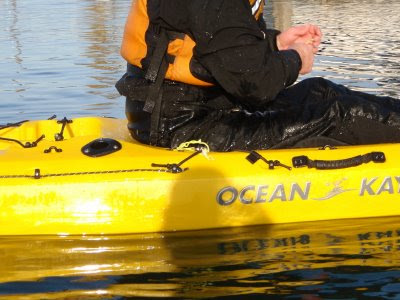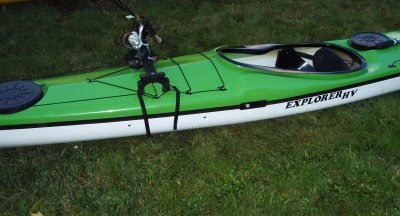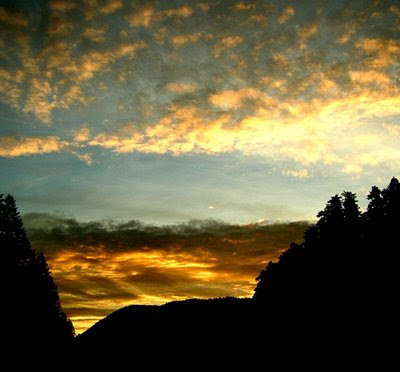Since I am off the water for a while due to injury, I thought this would be a good time to talk about kayaking safety. They say that 95% of kayaking accidents happen between the car and the water. Well I admit, I am now a part of that statistic.
While tying boats on a trailer, my left hand was pulling down on the rope as my right was pushing two boats together to get them nice and tight. My right hand slipped and I ran my fingers into the coming of one of the boats. This was the result:

I have to admit, I used to think the
pinkie was an expendable digit; The biggest slacker of all the fingers. What I've come to realize is that
pinkie is a VITAL member of the team. He's the helper, the
assister, and deeply connected to the others.
Anyways, the doc snapped it back into place and splinted it up. In a few days I'm going to try to move it again, and hey, I got to use my new camera!
This got me thinking; What if this had happened while I was on the water by myself? What if I had done something worse, like dislocated a shoulder, or broke my entire hand or arm?
As a professional sea kayak guide and instructor, I have trained extensively to help others, but rarely do you think about how we would help ourselves if disaster struck.
The obvious response to an immobilizing injury while solo kayaking is to call for help. I am lucky enough to paddle where the coast guard is everywhere. A VHF marine radio set to emergency channel 16 has a pretty good chance of getting through to the coast guard, or other mariners in the area. A cell phone is also handy, and can be used to call friends, emergency services, etc.
A dislocated
pinkie does not qualify for coast guard rescue. I probably would have called a friend on a cell phone and asked them to meet me at the nearest take out, and painfully paddled in to meet them.
The most important thing is to STAY CALM, clearly assess the situation, formulate a plan, and TAKE ACTION! Someone has to take charge of the situation, and it might be you, even if you are the one injured. Freaking out and panicking only clouds your judgment, and causes you to make irrational and/or illogical decisions. Adrenaline=good. Panic=bad.
KAYAK SAFETY GEAR:
Emergency Kit
Let's talk about the basic safety kit. This may seem like overkill, until you have an accident. I
always tell my students; "Do you plan on getting in a car wreck
every time you put your
seat belt on?" These are things I
ALWAYS have in my boat, even if I'm paddling on a flat water lake:
Cell Phone: Fully charged with spare battery.
Kept in a dry box,
inside a dry bag, in my day hatch, or other easily accessible, but secure location.
VHF Marine Radio: Absolutely necessary for kayaking in any marine environment. Kept close at hand for communication
between a group of
separated paddlers, contacting the coast guard or other mariners close by, and for obtaining current weather and ocean conditions.
How to use a VHF: A call of
pan-pan means there is an emergency on board kayak, boat, aircraft, or other vehicle but that, for the time being at least, there is no immediate danger to
any one's life or to the vessel itself. This is referred to as a state of
urgency. This is distinct from a call of
mayday, which means that there is imminent danger to life or to the continued viability of the vessel itself. Thus 'pan-pan' will inform potential rescuers (including emergency services and other craft in the area) that a safety problem exists whereas 'mayday' will call upon them to drop all other activities and immediately instigate a rescue attempt.
A
mayday situation is one in which a vessel, aircraft, vehicle, or person is in grave and imminent danger and requires immediate assistance. Examples of "grave and imminent danger" in which a mayday call would be appropriate include sinking, drowning, broken back...basically potential death.
Mayday calls can be made on any frequency, and when a mayday call is made no other radio traffic is permitted except to assist in the emergency. A mayday call may only be made when life or craft is in imminent danger of death or destruction.
Although a mayday call will be understood regardless of the radio frequency on which it is broadcast, first-line response organizations monitor designated channels: Marine VHF radio channel 16 (156.8 MHz). A mayday call is roughly equivalent of a Morse code SOS, or a telephone call to the emergency services.
When they receive a mayday call the coastguard may launch life boats and helicopters to assist the ship that is in trouble. Other ships that are nearby may divert course to assist the vessel broadcasting the Mayday.
Making a hoax mayday call is a criminal act in many countries because of the danger to the rescuers' lives that a search and rescue operation can create, as well as the very high costs of such rescue efforts. For example, making a false distress call in the U.S. is a federal crime carrying sanctions of up to six years imprisonment, and a fine of $250,000.
The coastguard can be contacted in situations that are not emergencies (out of fuel, etc.) by calling 'Coastguard, Coastguard, Coastguard, this is (name of vessel)', on VHF channel 16. In many countries special training and a license are required to use a mobile radio transmitter legally, although anyone may legally use one to summon help in a real emergency.
The recommended distress call format includes the word MAYDAY spoken three times (repeated twice), followed by the vessel's name or call sign, such as; "Kayak Vessel Explorer", also spoken three times, then MAYDAY and the name or call sign again. Vital information, including the position, nature of the emergency, assistance required and the number of people in the group, should follow. A typical message might be:
- "MAYDAY, MAYDAY, MAYDAY, this is Kayak Vessel Explorer, Kayak Vessel Explorer, Kayak Vessel Explorer. MAYDAY, Kayak Vessel Explorer. Position 54 25 North 016 33 West. My kayak is damaged and sinking. I require immediate assistance. I am by myself. OVER."
If a Mayday call cannot be sent because a radio is not available a variety of other distress signals and calls for help can be used. A Mayday can be sent on behalf of one vessel by another, using a convention called a
Mayday Relay.
Click here to watch the coast guard rescue kayakers in distress.
Note: They don't save your boat.
Emergency Contacts/Action Plan: Names and numbers of emergency services specific to the area you are paddling. Laminate & keep with cell phone in a dry box, inside a dry bag.
Do you know where the nearest hospital, or coast guard station is and how to get there? Where are your emergency take outs along your intended route? Could you easily describe your location if the situation should arise?Charts, Maps, & GPS: Having
charts, maps, compass and/or a GPS on board, and knowing how to read and use them is vital.
Signaling Devices: Hand held smoke and aerial/parachute flares, dye markers, fire starter, signal mirror, whistle, LED light on my
PFD, reflective tape on my dry suit,
PFD, paddle, and kayak.
First Aid Kit: In a dry bag, inside a hatch. Don't skimp on this one. Buy a deluxe medical kit. Go through every item, and supplement for your personal needs. On a recent San Juan Island trip, I was stung inside my mouth by a yellow jacket. Crazy, I know. I dug through my deluxe med kit only to find that there was no antihistamine of any kind. I have since added many items to my kit to cover every situation I could think of.
Emergency Shelter: Storm
cag, tarp, space blanket, sleeping bag: Some things to get you and others out of the elements and retain body heat. These items are available at most outdoory stores, such as REI, etc.
Extra Warm & Dry Clothes: Hypothermia is
always a risk in the Pacific Northwest. I carry a spare fleece full body suit, long
underwear, splash pants & top, gloves, and warm hats, inside a dry bag in a hatch.
Hot Drink: Taking tea bags and a thermos filled with hot water is
always a good idea. A
hypothermic person can "cuddle" with the hot bottle for warmth or have a hot drink.
Caffeine can help stimulate the body. I will also take a stove, like the
MSR pocket rocket, and fuel, on extended trips. A stove comes in handy for making hot food and drink in a pinch.
Sugary Snacks: Always lifts the spirits, give a quick boost of energy, or help a diabetic reaction. Remember when you were a kid and scraped your knee? Didn't a sweet treat from Mom
always make it better? Who doesn't like chocolate?
KAYAK SAFETY GEAR:
Personal Safety Items Personal Floatation Device (PFD):
Personal Floatation Device (PFD): A
PFD is one of the most important items for safety. If you find yourself in the drink, it will float you with no effort from you.
PFDs should be worn at all times, and are required by law in most states.
Paddle Float: Can be used to stabilize a kayak for re-entry, or a
disabled paddlers boat for towing, and many other things. Should be secured to the deck or behind the seat. Must be accessible without opening a hatch while you are out of the kayak.
Bilge Pump: Necessary to drain a flooded kayak while still in the cockpit. Should be easily accessible.
Helmet: A helmet should be worn at all times in white water, and in moderate to big surf in and around rocky areas.
Tow Line: I prefer a
waist mounted, quick release tow belt such as the one by
Northwater.
Throw Bag: Nice to be able to throw someone a line if they get sucked away!
Dive Knife: There are lots of good dive knives on the market. Gerber makes some of my favorites. Make sure it is secured to your PFD so you can get to it in a pinch, say, if your tow line gets wrapped around your neck. If you are as clumsy as me, make sure you get one with a rounded tip, rather than a point.
Spare Paddle: A spare paddle should be kept on the deck securely. Make sure you can access & utilize while you are in the cockpit. You don't necessarily need a $400 carbon fiber paddle for your spare, but you don't want the cheapest one you can find either. Ask yourself; would I want to paddle with this thing in harsh conditions all day? If the answer is no, get a spare you are comfortable with. You'll thank yourself when you actually have to use it.
TIP: I like to keep my spare paddle & bilge pump on the front deck. In almost every situation, you want to try and keep the back deck of the kayak free of gear. The reason being that most re-entry techniques require the swimmer to belly up on the back deck in order to get back in the cockpit. The last thing you want if you've been bucked from the boat is to get your PFD hung up on all the junk on your back deck. KEEP IT CLEAR! Make sure what ever items you've chosen to keep on deck are secure. Punching out through surf, a wave breaking over the deck, or even a capsize will quickly send your gear sinking/sailing away. I call this a "yard sale".VIDEO:
Yard Sale: This guy needs to take a lesson. He is clearly out of his skill set. He's even holding the paddle upside down.VIDEO: More
wipe-outs from my kayak fishing brethren.
VIDEO: Finally a
successful surf landing!
KAYAKING SAFETY GEAR:
Clothing
You've probably heard the saying; "Dress for the swim, not the paddle." Well, it's true. It's important to assess conditions to determine proper kayaking attire. Here in Oregon, on the ocean I wear
neoprene booties, wool socks,
fleece bottoms & a fleece top under a
Kokatat Gore-Tex dry suit pretty much year round. The sea water here rarely gets above 58 degrees, and a prolonged swim in water that cold can be debilitating. I
generally believe it's better to be to warm than to cold, as it's pretty easy to cool off. Just roll your kayak and you're instantly cooler.
Wetsuits are another option for cold water. I don't find them as comfortable as a
dry suit, but they are much more affordable, and can be layered with a
neoprene top & splash gear to provide more warmth.
Dry tops & bibs/pants are OK, and will get you through most situations pretty dry. If you find yourself in the water for prolonged periods of time, they are likely to let some water in.
I usually don't wear gloves, but I
always have a pair handy just in case.
KAYAK SAFETY GEAR:
SummaryThe key with your safety gear is to err on the side of caution. Don't get lazy or complacent, thinking that you won't need this stuff. It's better to have it and not need it, than to need it and not have it.
It's also important to learn how to properly use these items. If you don't know how to use a
paddle-float, flare, VHF, or find your position on a chart,
take the time to learn now. There are plenty of resources available for instruction. Having all the gear in the world wont do you a bit of good if you don't know how to properly use it.
Take a CPR/First Aid class & stay current. Get familiar with your kit and where things are. Take rescue classes and practice with your paddling partners. Anyone who sits in a kayak has a responsibility to themselves, and our emergency services to understand and practice these scenarios.
Most importantly; Never put yourself in a situation above your experience level.
Always train for it and work your way up to it. While you are developing your skill and understanding of the ocean, paddle with a more experienced partner.
Next week I will talk about self, and assisted rescue/re-entry techniques. Knowing how to get yourself and others back in their kayak is fundamental for all paddlers. I'm headed back to the Oregon Coast next weekend for another run at fishing for salmon from a kayak. There isn't much time left before the salmon are done, and I start white water kayak fishing for
steelhead!
-Jason











































